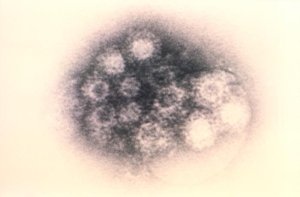California’s first cases of a virus that has been spreading across the country this year were confirmed Thursday by the state’s chief health official.
Four cases of enterovirus D68 have been confirmed, all in Southern California. One was in Ventura County; three others were in San Diego County.

The patients’ ages ranged from 2 to 13 years old.
More instances of the disease were expected as results from lab tests come back, the California Department of Public Health said in announcing the cases.
The virus can cause severe respiratory illness in young children and has sent dozens to the hospital across the country.
The spread of the disease to California was expected, state health officer Dr. Ron Chapman said. As of Wednesday, 18 other states had confirmed 153 cases total cases of the virus, according to data from the Centers for Disease Control and Prevention.
“There will definitely be more. It’s just a matter of time. This will spread across the entire country,” Dr. Pia Pannaraj, an infectious diseases specialist at Children’s Hospital Los Angeles, told KTLA.
California joins Montana and Colorado as being the only states in the Western U.S. to have confirmed cases in 2014.
This particular strain of non-polio enterovirus was first identified in California in 1962, but has been uncommon in the U.S., according to the CDC.
Earlier this year, researchers at Stanford University and UC San Francisco reported that two of five children in California who came down with mysterious polio-like paralysis of their limbs had tested positive for enterovirus-68 in samples given between August 2012 and July 2013.
The virus generally causes respiratory illness, with possible symptoms including fever, runny nose, sneezing, cough and body and muscle aches. Children who contract the virus may have more serious effects, including breathing difficulty and wheezing, particularly children with a history of asthma.
“These children start with what seems like a normal cold on the first day — runny nose, a little bit of cough – but by the second day, they can’t breathe at all. They come in and they need a tube to help them breathe,” Pannaraj said.
Parents whose children begin to have difficulty breathing should seek medical attention for them immediately, the state health department advised. Signs that should prompt a quick response include wheezing, difficulty speaking or eating, the child’s belly pulling in with breaths, and blueness around the lips.
The virus is believed to spread when an infected person coughs, sneezes, or touches contaminated surfaces. There is no vaccine to prevent spread of the disease, nor is there a specific treatment that can be prescribed.
“It’s probably evolved in a way that’s allowed it to spread more easily from person to person, and that’s why we’ve seen so many more cases this year,” Pannaraj said.
Infants, children and teenagers are most likely to get infected with enteroviruses because they do not yet have immunity, according to the CDC.
The CDC advised the following steps to help parents try to prevent their children from becoming ill:
- Avoid close contact with sick people;
- wash your hands often;
- cover your coughs and sneezes;
- avoid touching your face with unwashed hands;
- clean and disinfect surfaces
- stay home when you’re sick.
Children’s Hospital Los Angeles provided the following Q&A with Dr. Pia Pannaraj. She explains how parents can treat their children’s symptoms and how to distinguish between at bad cold and Enterovirus 68.
What is Enterovirus 68?
Pannaraj: It is a virus that causes cold-like symptoms that is currently being seen in the Midwest. It has been around since the 1960’s and first discovered in California with just a few cluster of cases. Now, it is showing itself again and is slowly creeping across the country.
How frightened should parents be about their kids getting Enterovirus 68? Especially if they live outside of the Midwest?
Pannaraj: Currently, it is in the Midwest, but it has just made its way to California. In many kids, it will cause a bad cold, but in children with asthma, it can exacerbate their asthma to the point where they may need medical attention.
Are children with underlying conditions more susceptible to Enterovirus 68?
Pannaraj: So far, 70 percent of patients admitted to hospitals with Enterovirus 68 have underlying respiratory illness, like asthma; 30 percent were previously healthy
How can parents differentiate between a bad cold and this virus?
Pannaraj: It will be difficult to distinguish the two since enterovirus will cause a cold. Children will usually present with a cough as their main symptom. Other symptoms may include runny nose, sneezing, and body and muscle aches. However, a fever is not very common with Enterovirus 68. The children who become very ill with Enterovirus 68 develop wheezing and difficulty breathing.
What are some prevention tips?
Pannaraj: Good hand washing, avoid touching your eyes, nose and mouth, cough and sneeze into your arm, and avoid other children who appear sick. It can spread easily and anywhere, especially at schools, where infection risks are at higher because you have more kids in close quarters. It is airborne and contagious.
How should parents treat their kids’ symptoms?
Pannaraj: Rest and hydration. Treat it the same way you would a bad cold. Keep the kids out of school.
Is there a vaccine for Enterovirus 68?
Pannaraj: A vaccine is not available at this time.
When should they seek medical attention for their kids?
Pannaraj: If a child is wheezing, having trouble breathing, coughing so much that they cannot talk, or having difficulty drinking, they should seek medical attention. Children with asthma should be prepared with medical inhalers as needed.
Clarification: An earlier version of this story failed to state that the enterovirus-68 cases reported by the state’s health department were the first in California in 2014. The story has been updated to reflect that, and information on research related to two other diagnoses has been added.
More Video:















